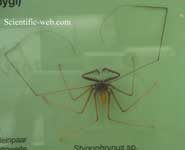
| Amblypygid | ||||||||
|---|---|---|---|---|---|---|---|---|
| Scientific classification | ||||||||
|
||||||||
| Families | ||||||||
|
Paracharontidae |
Amblypygi is an order of invertebrate animals belonging to the class Arachnida, in the subphylum Chelicerata of the phylum Arthropoda.
Amblypygids are also known as whip spiders and tailless whip scorpions (not to be confused with whip scorpions that belong to the Arachnid order Thelyphonida). The name "amblypygid" means "blunt rump", a reference to a lack of the telson ("tail") carried by related species.
As of 2002, approximately 5 families, 17 genera and 136 species have been described. They are found in tropical and subtropical regions worldwide. Some species are subterranean; many are nocturnal. During the day, they may hide under logs, bark, stones, or leaves. They prefer a humid environment.
Physical description
Amblypygids may range from 5 to 40 cm. Their bodies are broad and highly flattened and the first pair of legs (the first walking legs in most arachnid orders) are modified to act as sensory organs. (Compare solifugids, uropygids, and schizomids.) These very thin modified legs can extend several times the length of body. They have no silk glands or venomous fangs, but can have prominent pincer-like pedipalps.
Behaviour
Amblypygids often move about sideways on their six walking legs, with one "whip" pointed in the direction of travel while the other probes on either side of them. Prey are located with these "whips", captured with pedipalps, then masticated with chelicerae.
Courting rituals involve the male depositing stalked spermatophores which have one or more sperm masses at the tip on the ground and guiding the female with his pedipalps over them.[2] She gathers the sperms and lays fertilized eggs into a sac carried under the abdomen. When the young hatch, they climb up onto the mother's back; any of which falling off before their first moult will be eaten by the mother.
Amblypygids, particularly the species Phrynus marginemaculatus and Damon diadema, are thought to be one of the few species of arachnids that show signs of social behavior. Research conducted at Cornell University by entomologists suggests that mother amblypygids comfort their young by gently caressing the offspring with her feelers. Further, in an experiment where two or more siblings were placed in an unfamiliar environment, such as a cage, they would seek each other out and gather back in a group.[3]
History
Fossilized amblypygids have been found dating back to the Carboniferous period, for example Graeophonus.
Genera
- Paleoamblypygi
- Paracharontidae:
- Paracharon Hansen, 1921
- incertae sedis:
- Graeophonus† Scudder, 1890
- Euamblypygi
- Charinidae:
- Charinus Simon, 1892
- Catageus Thorell, 1889
- Sarax Simon, 1892
- Charontidae
- Charon Karsch, 1879
- Stygophrynus Kraepelin, 1895
- Phrynichidae
- Damon C.L. Koch, 1850
- Euphrynichus Weygoldt, 1995
- Musicodamon Fage, 1939
- Phrynichodamon Weygoldt, 1996
- Phrynichus Karsch, 1879
- Xerophrynus Weygoldt, 1996
- Trichodamon Mello-Leitão, 1935
- Phrynidae
- Paraphrynus Moreno, 1940
- Phrynus Lamarck, 1801
References
1. ^ Pocock, R. I. (1900) (Scanned version). Fauna of British India. Arachnida. http://www.ub.ntnu.no/scorpion-files/pocock_fauna_india.php.
2. ^ Weygold, Peter (1999) Spermatophores and the evolution of female genitalia in whip spiders (Chelicerata, Amblypygi). The Journal of Arachnology 27:103–116 PDF
3. ^ Jeanna Bryner (2007-03-19). "Creepy: Spiders Love to Snuggle". LiveScience.
External links
- Picture of a Mexican amblypygid (referred to as a "tailless whip scorpion") and its habitat
- Acanthophrynus coronatus from Jalisco, Mexico (largest known amblypygid)
- Amblypygid from Jalisco, Mexico
- Amblypigid video summarizing research from University of Nebraska's Eben Gering.
- NPR Science Friday show that makes mention
- Amblypygi. The Antillean (West Indian) fauna.
- Whip Spider Whip Spider photographed in the Manu National Park, Peru.
Retrieved from "http://en.wikipedia.org/"
All text is available under the terms of the GNU Free Documentation License

